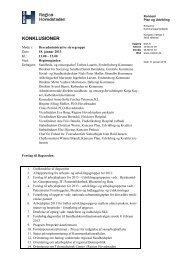Territorial Review Copenhagen - Region Hovedstaden
Territorial Review Copenhagen - Region Hovedstaden
Territorial Review Copenhagen - Region Hovedstaden
Create successful ePaper yourself
Turn your PDF publications into a flip-book with our unique Google optimized e-Paper software.
151<br />
and which will link the Danish island of Lolland with the German island of<br />
Fehmarn, thus substantially reducing the travelling time between<br />
<strong>Copenhagen</strong> and mainland Germany. It is expected to be completed in 2018.<br />
Denmark‘s domestic transportation system is well developed. Currently,<br />
its main transport infrastructure consists of the road network, railway<br />
network, 23 airports including <strong>Copenhagen</strong> Airport, and 120 seaports<br />
(Statistics Denmark, 2008). Road and railway network form the shape of the<br />
―Big H‖. A well-developed and high-quality transportation system of roads,<br />
railways, airports and ports has given Denmark a top ranking in the IMD‘s<br />
World Competitiveness Yearbook and in the World Economic Forum‘s<br />
Global Competitiveness Report for several years. The challenge will be to<br />
strengthen external links with Nordic countries and European continent.<br />
A recent achievement in the <strong>Copenhagen</strong> metropolitan area is the<br />
opening of the metro system. In 1992, the Danish Parliament permitted the<br />
construction of a metro railway infrastructure and the development of a new<br />
district (Ørestad) in <strong>Copenhagen</strong>. Metro construction started in 1994, and<br />
the first phase was completed and opened to the public in 2002. The<br />
continuing construction expanded the metro system, including the link<br />
between the city centre and the international airport in 2007. Currently, the<br />
city ring line is being constructed and will be completed at 2018 at the<br />
earliest. When the city ring is finished, 85% of all traffic destinations in the<br />
city centre will be within 600 metres of a Metro or S-train station. The metro<br />
is fully automated and operated from a computer centre in Ørestad. The<br />
automation enabled high frequency of as much as 100 seconds of interval<br />
during rush hours and two to three minutes during off-peak hours. The<br />
system is stable, with 99% of trains on time in 2007. Construction costs are<br />
financed by user fees and proceeds from real estate development abutting<br />
the metro line, making the project financially self-supporting (Box 2.4).<br />
Some studies show the impact of the metro opening on transportation in<br />
<strong>Copenhagen</strong> as positive in terms of traffic growth, inducing more longdistance<br />
travel. The metro opening also caused some modal change. The<br />
metro carried around 40 million passengers in 2007. The Metro Rail<br />
conference, consisting of experts from metro systems around the world,<br />
awarded the <strong>Copenhagen</strong> Metro the ―Best Metro‖ award in 2008. It is<br />
reported that the experts highly evaluated its operational reliability, the<br />
speed of the new line to the airport, the system‘s safety level, and the<br />
growing passenger rating.

















